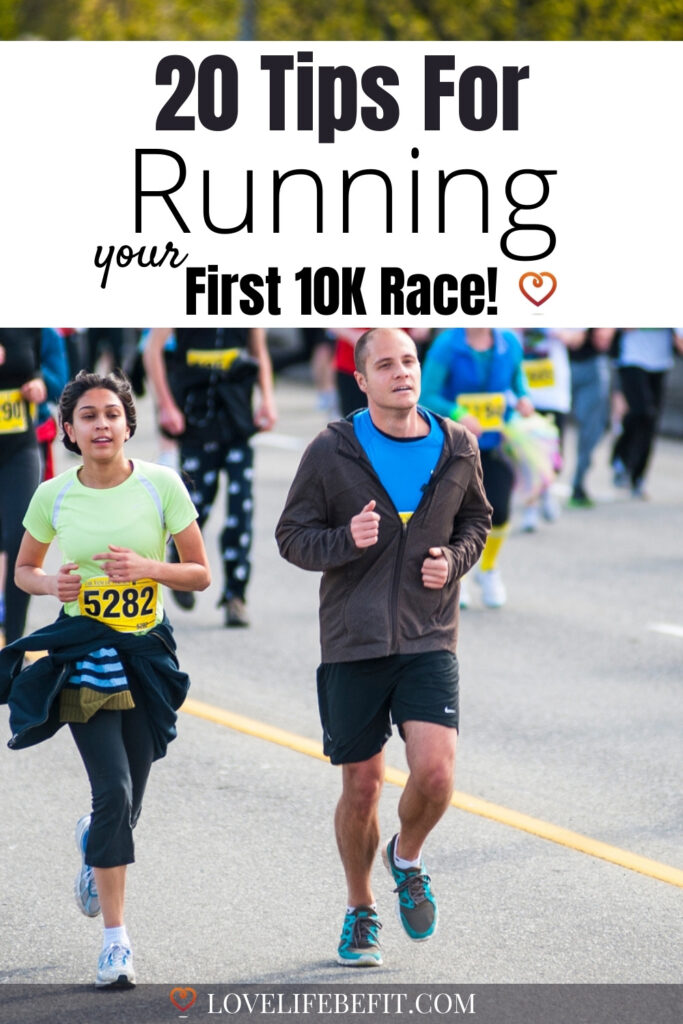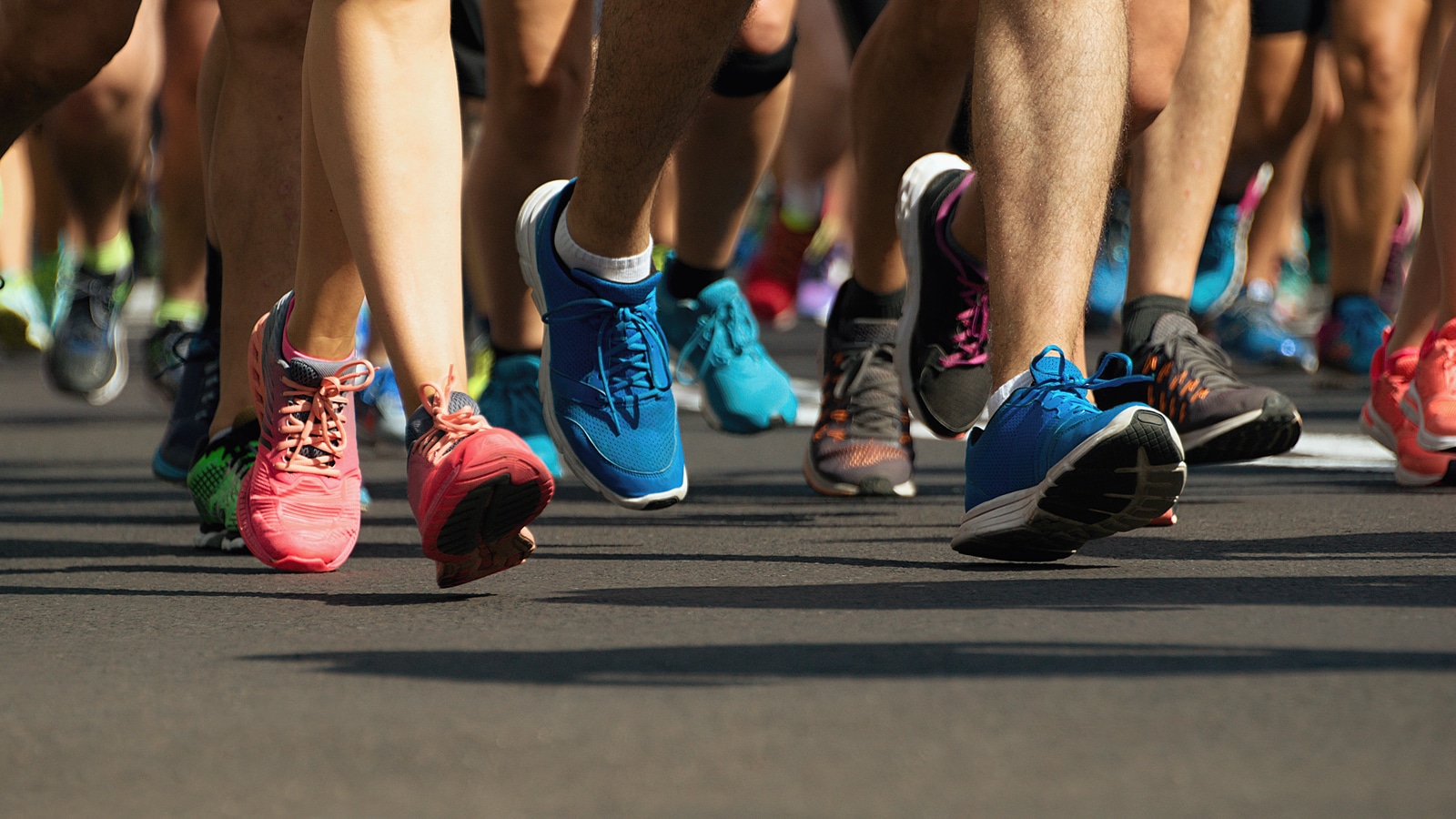20 Must-Know Tips For Running Your First 10K Race
Ready for your first 10K race? A 10K race is an ideal challenge if you’re a beginner runner. It’s a big step up from shorter races – fun runs of 5K but still an achievable challenge for most new runners. A 10K is a fun mix of speed and endurance.
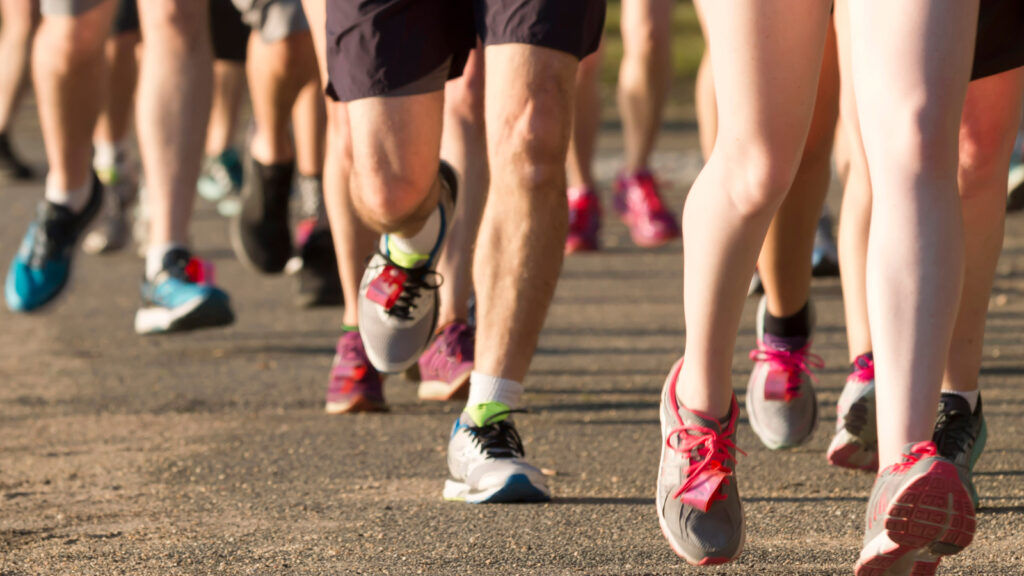
Running A 10K For The First Time
Preparing for a 10K race takes a bit more time and effort than running a shorter race. If you’re new to running, start by following a beginner’s training plan for several weeks leading up to the race. As the race gets closer, increase your long run distance so that you’re able to comfortably run six miles or ten kilometers (the race distance) a week before the big day.
On race day, start out slow and easy. The first mile will always feel fast but resist the urge to go out too hard. It’s a mistake many new runners make! Remember that you have to pace yourself over the entire distance and it’s better to start too slow than too fast. After the first mile, settle into a comfortable pace that you can maintain for the rest of the race. Save your energy for the last few miles when you’ll need it most. If possible, try and speed up over the last mile – you’ll feel that you’re racing!
Cross the finish line feeling strong and proud of your accomplishment! Completing your first 10K race is a huge achievement. Remember to enjoy the process and listen to your body along the way. With a little bit of preparation, you’re sure to have a great first experience running your first 10K race!
Related post: 5K to 10K training plan.
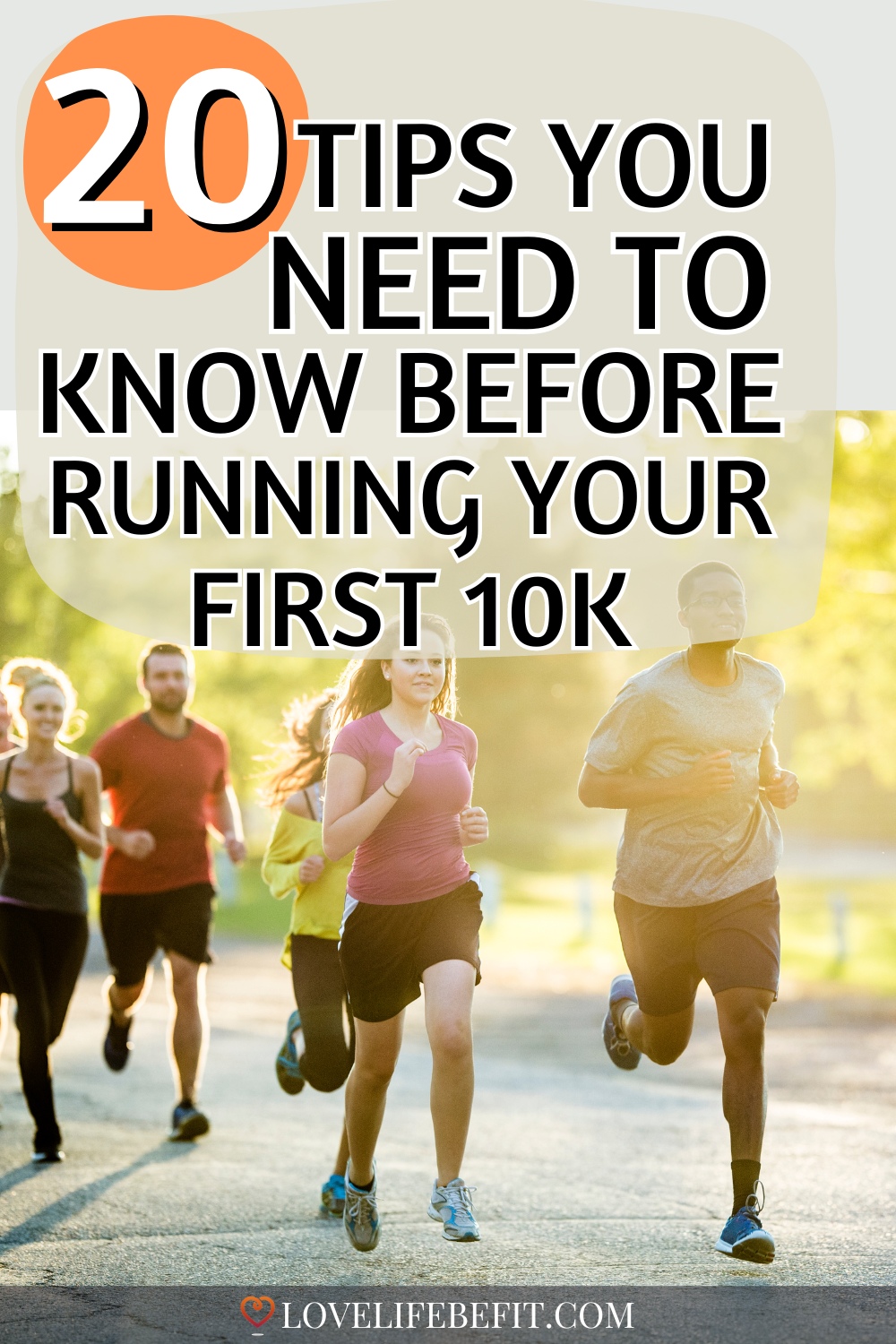
First 10K Tips – Preparing For Your First 10K Race
Follow these top tips to get the most out of your first 10K…
#1 Run Often To Train For Your First 10K
You do need to run regularly to tackle 10K. Aim for three times a week with two 30-minute runs on weekdays (say Tuesday and Thursday) and one longer run at weekends. Most of your running will be easy runs. You’re aiming to run longer distances – building your leg strength and endurance.
Try and fit in an extra 20-minute run at the weekend if possible, the day before your long run. But don’t skip your rest days! A good training program will increase your mileage gradually and still allow plenty of time for rest and recovery.
You’ll be getting stronger and improving your running form. As you become a more experienced runner, you’ll be running with greater efficiency and running economy – running gets easier the more you do it!
Related Post: Running Form – Should You Change Your Running Technique?
#2 Go Longer And Try Tempo Runs
Your weekend run is a chance to increase your distance. Every weekend increase your long run by 0.5 to 1 mile. You’ll be confident you can complete a 10K race if you’ve already run this distance in training. It will help if your longest run before the race is at least 5 miles.
Try a tempo run where you run 3 miles at your target 10K race pace. A local parkrun is ideal – instead of racing around the 5K route run at your 10K pace use the run for training. It should be challenging running but less effort than a vigorous or race pace.
Related Post: What Is RPE In Running? (And Why Should You Use It?)
#3 Speed Work
Add fartlek sessions to your training runs. Fartlek is a type of speed training or interval training that alternates between periods of fast running and easy effort. You run to feel with no set time for the fast and slow intervals.
It’s a great way for beginner runners to gradually increase running speed and pace. Your building speed and strength without demanding too much from your body. There’s less risk of injury compared with hard interval sessions or running hill repeats – leave these for experienced runners.
Related Post: How To Run Faster
#4 Strength Train
Strength training is one of the most important things you can do as a new runner. It’s a way for guarding your body against injury.
Try yoga for runners or specific bodyweight exercises for runners.
Related Post: Yoga For Runners
#5 Add In Some Cross-Training
When you train for your first 10K, it’s always good to mix things up. Cycling and swimming mix well with running training. Hitting the gym or doing circuits will help strengthen your core. You’re training for running strength, not big bulky muscles.
Related Post: The Best Cross Training For Runners

Tips For The Week Before Your Race
The hard work is done, follow these tips to prepare for your race…
#6 Relax & Taper
You’ve completed your training. Packing in extra runs in the week before the race won’t help. It may do more harm than good. Relax and let your body recover. Taper your training in the last week before the race. Do some light runs to keep your legs loose but don’t overdo it.
#7 Make A Race Plan
Plan your race and have a strategy. Decide what pace you want to run and stick to it. A good rule of thumb is to start at a steady pace and if you’re going well, pick up speed in the second half of the race. This is called a negative split where you run the second half faster than the first.
It’s not easy to do. Most runners get carried away at the start of a race and set off too fast – fading and struggling over the finish line.
#8 Set A Target Pace
Sticking to a good race plan is much easier if you have a target pace. Don’t expect to just double your 5K time. It’s a longer race than 5K so your pace will be slower. Use a race time predictor to come up with an achievable running pace and time goal. Once you know your goal race pace – stick to it!
#9 Get Your Running Kit Ready
Make sure you have everything you need for race day.
- A good pair of running shoes
- Comfortable clothes to run in
- Race number & timing chip (if your race is timed)
- Something to carry your energy gels & water (a running belt or race vest)
Related Post: Women’s Running Clothing
#10 Check The Weather Forecast
Check the weather forecast and dress appropriately. If it’s going to be hot, wear light, breathable clothing. If it’s cold, make sure you have some warm gear to throw on before and after the race. And if it’s going to rain… well, just hope for the best! You could run in a waterproof if it’s really wet but the chances are you’ll overheat.
#11 Plan Your Transport & Arrival Time
Make sure you know how you’re getting to the race start and plan your arrival time. You don’t want to be rushing around or panicking on race day morning.
Arrive in plenty of time to warm up, use the toilet, and get to the start line.
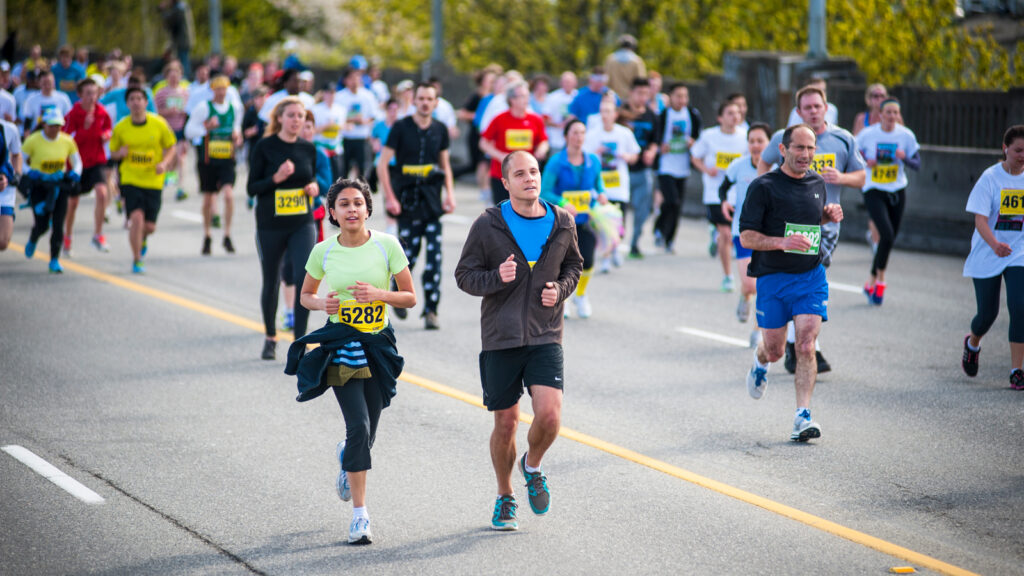
What To Do On Race Day
Make sure your race is a success by following these tips on the morning of the race…
#12 Warm Up Properly
Warm up before the race with some easy running and dynamic stretching. It’s important to loosen your muscles and get your heart rate up before the race starts. A good warm-up will help you avoid injury and perform better on race day.
#13 Find The Toilets
This is an important one! There are few things worse than needing the toilet during a race. Go before the race starts. Expect queues – everyone will have the same idea. I always have some toilet paper in my race bag just in case it’s needed.
#14 Start At A Steady Pace
Don’t start too fast! It’s tempting to go out hard at a fast pace when the race starts but it’s not sustainable. You’ll quickly tire and end up walking.
Start at a comfortable pace that you can maintain for the whole race. I always like to start feeling like I’m running at an easy pace. Your mind plays tricks on you and that “easy pace” at the start of a race will still be fast.
It’s almost impossible to set off slowly at the start line when you’re full of adrenaline and fired up by the excitement of the race. But try not to start at a sprint! If you’re running with a GPS watch or app, use it to make sure you’re running at your goal pace and not getting carried away.
#15 Run Your Own Race
Focus on your own running and don’t worry about anyone else. It can be distracting (and disheartening) to compare yourself to other runners, especially if they seem to be flying past you. Remember, everyone has different fitness levels and race strategies. Stick to your planned race pace.
#16 Adjust Your Pace
Pacing yourself during a race is hard, especially if you’re new to running. But it’s important to stick to your plan.
If you find yourself going too fast, slow down a bit. It’s better to finish your first 10K race feeling you could have gone faster than badly fade halfway around and start to struggle. It’s always okay to take a walk break but try and get back to running as soon as you’ve caught your breath.
#17 Remember To Drink
As a new runner, a 10K race will be too far to run without taking on fluids, especially if it’s hot. Drink to thirst throughout the race so you stay hydrated.
If possible, practice carrying and drinking sports drinks on your long runs so you know how much you need to drink during a race.
Most 10K races will have water stations but you can also carry water with you – it’s best to use a race vest or wear a running belt with water bottles. Just make sure you practice with the vest or belt in training so it doesn’t feel strange on race day.
Related Post: Tips For Running In The Heat
#18 Take A Gel With You
If you think you’ll be running for more than an hour, it’s a good idea to take a gel or some sweets with you. This will give you an energy boost if you start to flag.
Again, it’s best to practice using gels on your long runs so you know how they affect you.
Some races will have gel stations but it’s always good to carry one just in case.
How To Enjoy Your First 10K Race
And finally, some tips to help you enjoy your race…
#19 Run With Friends
Running with friends is one of the best ways to enjoy your running. Find a training partner or join a local running club. Training and competing with other people for your first 10K will make the race a fun experience.
#20 Accept That Plans Change
It’s a huge shame when runners get too hung up on their finish time and forget to enjoy their first 10K race and be proud of their achievement.
Remember that your first race is just the beginning of your running journey. It’s a chance to learn about yourself as a runner and find out what you’re capable of.
So if things don’t go according to plan, don’t worry! Just enjoy the experience and use it to improve your performance next time.
Next Steps: Your First Half Marathon?
Completed your first 10K race? So what’s next? You could aim for your first half marathon or enter another 10K and try and run faster. Try my Couch to Half Marathon running program! I always find it best to set a new target as soon as you’ve completed a race. It helps to keep you motivated and progress as a runner.
Thanks for reading this post. I hope you enjoyed it and found it useful. If you have any tips of your own, please share them in the comments below. And if you’re a first-time runner, good luck with your training! 🙂
Running 101 Training Guides & Walking Schedules
5K Training Plans
- Couch To 5K Beginner Training Plan
- 12 Week 5K Training Plan
- 10 Week 5K Training Plan
- 8 Week 5K Training Plan
- 6 Week 5K Training Plan
- 4 Week 5K Training Plan
- 5K Training Plan Intermediate
